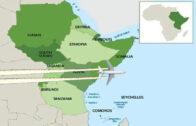African Geoengineering Push
MEMBERS & VISITORS:
African Geoengineering Push
As an African and geoengineering expert, I am acutely aware of the potential dangers and risks associated with geoengineering technology and its use. While some see it as a potential solution to climate change, others view it as a means of weather warfare and a tool for achieving full spectrum dominance over allies and enemies alike.
The term “full spectrum dominance” is a military concept that originated in the United States in the 1990s. It refers to the goal of the United State’s military to control all aspects of the battlespace, from the land, sea, and air to space and cyberspace. In essence, it means that the United State’s military seeks to have complete control over every aspect of modern warfare, leaving no room for its adversaries to mount an effective defense.
THE DIMMING: Exposing the Climate Engineering Cover-Up
The concept of full spectrum dominance was officially adopted as a key goal of United State’s military strategy in the early 2000s. It was included in the Quadrennial Defense Review (QDR) report published by the United State’s military Department of Defense in 2001, which outlined the United State’s military’s vision for the future.
The QDR report argued that the United State’s military needed to be able to operate effectively in all domains of warfare, including land, sea, air, space, and cyberspace, in order to achieve its strategic objectives. The report stated that “full spectrum dominance” was necessary to ensure that the United State’s military could prevail in any conflict, regardless of the nature of the threat.
The origins of the concept of full spectrum dominance can be traced back to the Cold War era, when the United State’s military focused on developing the capability to fight a large-scale conventional war against the Soviet Union. However, in the post-Cold War era, the United State’s military began to shift its focus towards smaller-scale conflicts, including counter-terrorism operations and peacekeeping missions.
The concept of full spectrum dominance emerged in the wake of the Gulf War in 1991, where the United State’s military’s use of advanced technologies such as precision-guided munitions and stealth aircraft demonstrated its superiority over Iraq’s conventional military. Since then, the concept has been embraced by United State’s military planners and has become a guiding principle of United State’s military strategy. The concept of full spectrum dominance emerged in response to this shift, as military planners sought to ensure that the US military would be prepared for any type of conflict, from high-intensity warfare to low-intensity operations. The goal of full spectrum dominance was to give the United State’s military the ability to dominate any adversary in any type of conflict, using a combination of conventional and unconventional tactics.
Overall, the push for full spectrum dominance was driven by a desire to maintain the United State’s military’s position as the world’s dominant military power, and to ensure that the United State’s military could achieve its strategic objectives in an increasingly complex and unpredictable global security environment.
However, some critics of United State’s military policy argue that the pursuit of full spectrum dominance has led to an arms race and an erosion of international norms and laws. They argue that the United State’s military’s pursuit of advanced technologies, such as geoengineering, for the purpose of achieving full spectrum dominance, poses a serious threat to global stability and security, particularly if it is used as a means of weather warfare or other forms of ecological manipulation against allies and enemies alike. Browse throught the following posts to learn how Geoengineering has become the primary tool of modern weather warfare.
Geoengineering techniques such as solar radiation management, ocean fertilization, and cloud seeding are all potential means of altering weather patterns and creating artificial weather events. While these methods may seem promising in theory, the reality is that the consequences of their use could be catastrophic. For example, solar radiation management could lead to unforeseen environmental impacts and potentially exacerbate existing climate issues. Similarly, ocean fertilization could disrupt the delicate balance of marine ecosystems and potentially harm marine life. But should we even be studying geoengineering at all? More than 400 senior climate scientists and scholars from around the world have called for an International Non-Use Agreement on Solar Geoengineering. If it goes before the United Nations, it could result in a ban on real-world research on this technology. See Geoengineering Background. https://inventionschool.tech/?s=geoengineering+chemtrail+atmospher
Moreover, geoengineering could be used as a tool for weather warfare and full spectrum dominance. In theory, a country or entity with advanced geoengineering capabilities could manipulate weather patterns to create natural disasters such as hurricanes, droughts, or floods, which could be used as a means of attacking or destabilizing another country or region. This could lead to significant human suffering, loss of life, and economic damage.
Furthermore, the use of geoengineering could lead to a situation where countries or entities with advanced capabilities hold an unfair advantage over those without such capabilities. This could lead to a situation where certain countries or regions are able to manipulate the weather for their own benefit, while others are left vulnerable to the consequences of these actions.
In conclusion, while geoengineering may seem like a promising solution to climate change, it is important to recognize the potential dangers and risks associated with this technology. It is essential that we approach geoengineering with caution and consider the potential consequences of its use, including its potential use as a tool for weather warfare and full spectrum dominance. I would further go so far as to say that the whole narrative of “climate change” could be the outcome of deliberate weather manipulation which has been actively pursued by the United States and others for more than thirty years as of 2023.
While the vast majority of scientific evidence supports the conclusion that climate change is largely due to excessive CO2 emissions, there are some arguments and studies that dispute this view. One argument against the link between CO2 emissions and climate change is that the correlation between the two is weak, and that other factors, such as solar activity and natural climate variability, play a more significant role. Another argument is that climate change is simply part of a natural cycle of warming and cooling, and that human activity has little to no impact on the overall trend.
Mechanical/Solar Engineer, Prof. Oku Singer
We have published other informative posts on Invention School’s website which may interest you. To view our entire catalog of over 800 posts go to inventionschool.tech/category/blog/ or use our handy search tool to find topics of interest to you.
Mechanical/Solar Engineer, Prof. Oku Singer
(27)






